
Published in 1968 and later adapted into the film Blade Runner, the famous science fiction work "Do Bionic Men Dream of Electronic Sheep? in which it was largely impossible to distinguish humans from bionics by appearance. It is not only it, but in many works of science fiction there are similar visions of a future in which there may be robots that are infinitely closer to humans physically.

▲Still from the movie Blade Runner, image from: The Guardian
The development of such humanoid robots has also continued over the years; for example, there are currently silicone skins made for robots that can mimic the appearance of a human to some extent, but are hardly as finely textured as human skin, such as wrinkles, and lack the skin's unique features.
But not long ago, a research team led by Professor Shoji Takeuchi at the University of Tokyo developed an artificial skin-covered robot finger. At first glance, this robotic finger may startle people and then make them wonder, "Is this really not a real person's finger?"
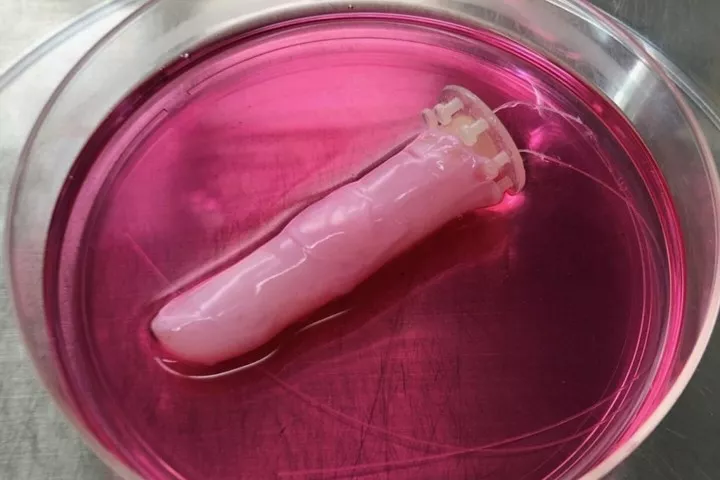
▲Image from: Shoji Takeuchi
If there would be these reactions, it actually shows just how much it is indeed bionic. In fact, the dermal equivalent that covers this skin model is made from the very same living human cells (fibroblasts, keratin-forming cells, etc.) and extracellular matrix (ECM) hydrogels (collagen, etc.).
The robot fingers are immersed in a solution of collagen and human dermal fibroblasts, the two main components that make up the connective tissue of the skin, and the mixture has a natural tendency to shrink, as if the fingers were coated with a 'primer' that also provides the basis for human epidermal keratin-forming cells.
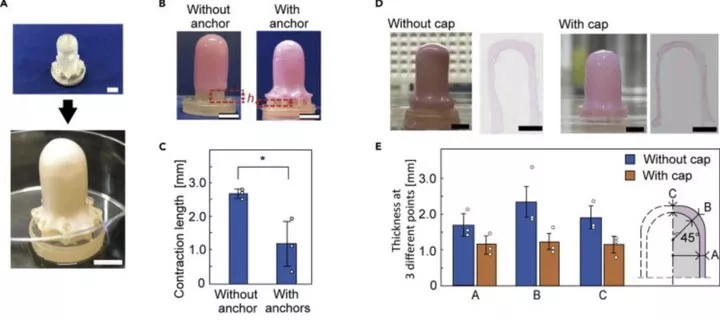
▲Image from: Shoji Takeuchi
This three-jointed robot finger, in addition to having an exterior form and texture very close to real human skin, it also functions similarly to real human skin. For example, this robot finger is waterproof like a human finger and the water droplets that form on the surface can be easily wiped off so that it can protect the internal electric motor and other parts from water.
Not only that, but it can straighten and bend like a human finger. The click from the motor paired with the movement and realistic look makes this robotic finger look more like a real finger.
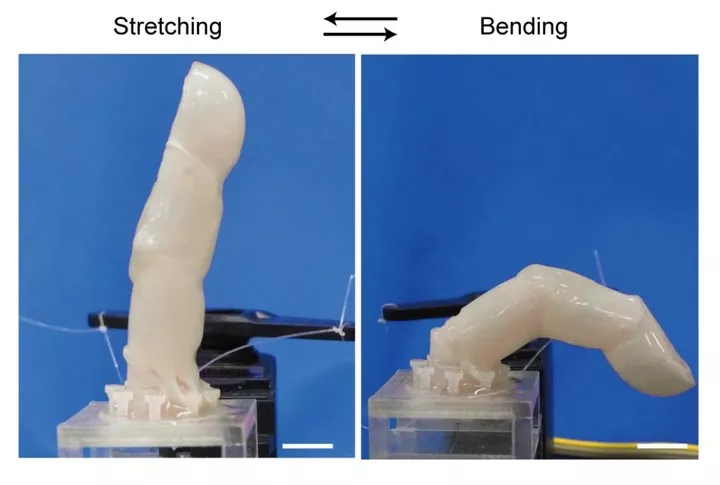
▲Image from: Shoji Takeuchi
What's more, the research team was originally inspired by the use of hydrogel for medical treatment of deeply burned skin, so the dermal equivalent covering the robot's finger also accomplished 'self-healing'.
In their tests, the researchers cut a small slice of skin off the robot's finger specifically and covered it with a collagen sheet. The collagen sheet was able to seal the wound, and after 7 days of incubation, the boundary between the transplanted decellularized collagen sheet and the original dermal equivalent became blurred, and the repaired finger, with the collagen sheet adhering to the dermal equivalent, was strong enough to withstand the tensile strain generated by repeated bending movements of the mechanical finger.

▲Image from: Shoji Takeuchi
Of course, research on such robotic fingers leaves much to be desired in terms of longevity and functionalization, such as the fact that it cannot lack proper water supply from the circulatory system and local wetting due to sweat secretion, and can currently only stay in a medium with fluid. Therefore the creation of perfusion channels within and below the dermis to mimic blood vessels to supply water, as well as the integration of sweat glands in the skin, are important directions for future research.
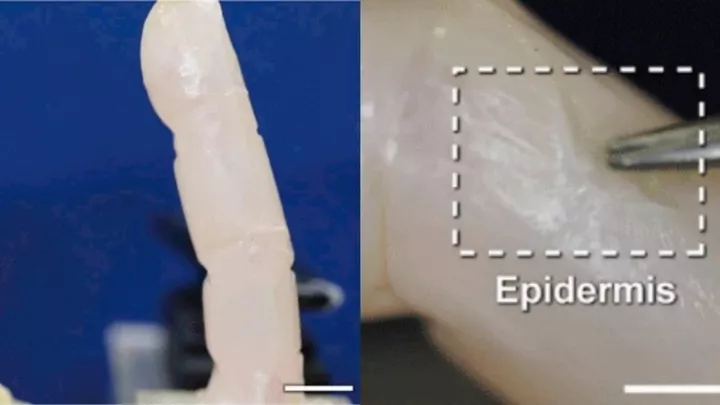
▲Image from: Shoji Takeuchi
Also, this wet culture condition leading to degradation of electronics and wiring should be noted. To further improve the functionality and physical autonomy of robotic fingers, the establishment of architectures with perfusable artificial vascular networks and biocompatible waterproof electronics coexisting side by side is likewise an important future focus, not only to maintain the viability of living skin, but also to be able to integrate electronic processors, motors, sensors, wires, batteries, communication modules, etc.
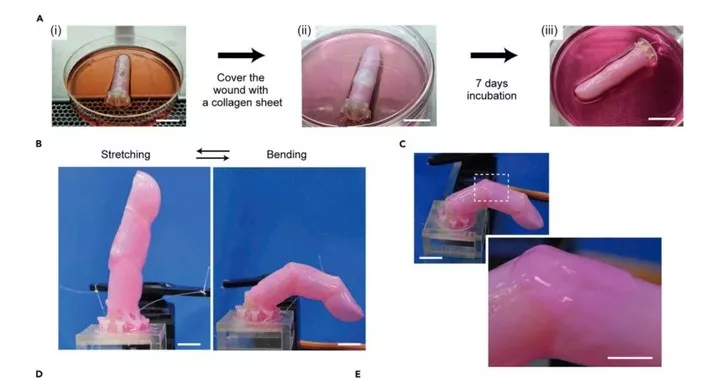
▲Image from: Shoji Takeuchi
However, the breakthrough in this research is undeniable. It proves that it is possible to mold skin tissue directly around robots, allowing skin to grow directly on robot parts. It also gives 'artificial skin' a texture and softness that silicone skin doesn't have, as well as a look and function similar to real skin, such as being waterproof, stretching with joint flexing and even repairing itself.
According to the research team's future plans, it also wants to develop more advanced versions by adding sensory neurons, hair follicles, nails and sweat glands, and also to try to cover larger structures.
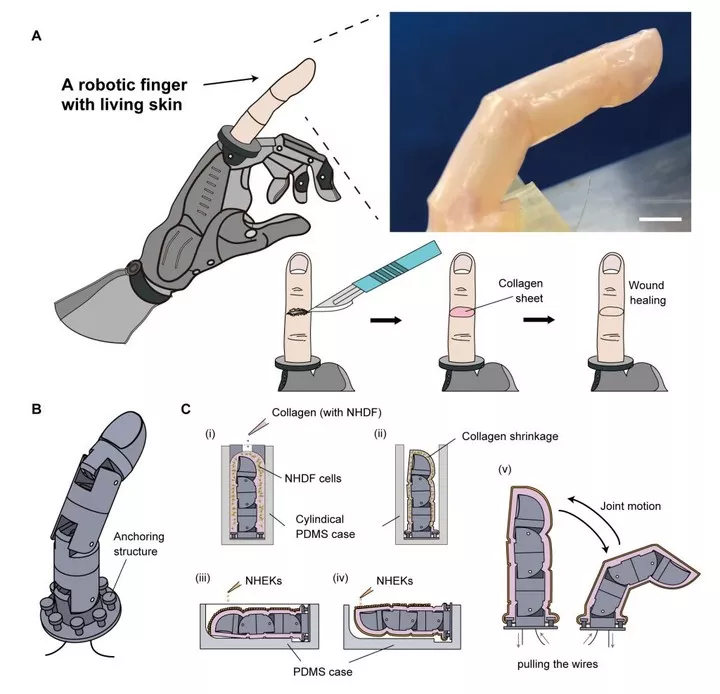
▲ Image from: Shoji Takeuchi
It is worth noting that this study may have one more item to note. It mentions in its research objectives that humanoid robots need a human-like appearance for some of their tasks in order to improve the efficiency of information exchange with humans and to evoke affection. In order to mimic the human appearance, it is imperative to develop humanoid overlay materials with realistic human skin tones and textures.
But in time, I fear that when faced with humanoid robots, especially those with skin so close to that of real people, there is no way to avoid the 'Valley of Terror Theory'. Humans may like robots that look like people, but can robots that look this much like people really still be liked?